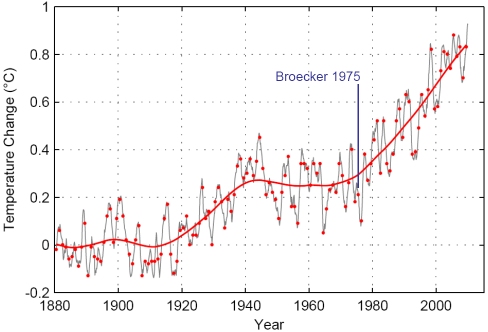[quote="Psudo]Zip hasn't criticized my taste-of-the-ocean analogy; why do you imagine he disagrees? For that matter, can you tell me what specifically is wrong with the analogy?
[/quote]
I just supplied the facts I know about the current CO2 concentrations, and the amount (estimated) of carbon we emit through fossil fuel combustion.
By doing so, I think I show that our rate of emissions is not mathematically insignificant, in comparison to the total mass of CO2 in the atmosphere.
The argument about how much is too much, or how an atmospheric component present at merely hundreds of parts per million is a bit of a distraction. I just plug the numbers into this:
C(o) is the original concentration of CO2 in ppm, C is the current concentration and delta F is the radiative forcing.
The relationship between temperature and radiative forcing is:
Where the squiggle (lambda) is the climate sensitivity (note, in K/(W/m2) not in degrees).
The entire edifice of catastrophic global warming is based on water vapour positive feedback. That is, changes to water vapour (which is also a greenhouse gas) will amplify the effect of the CO2 alone. That could be, I suppose. To be honest, once the argument gets too far past radiation physics, I don't really get it.
To repeat myself, "A tanker of salt is not at all similar in scale to all of the atmospheric carbon produced in the past century and a half. I never believed it was, nor said it was, nor hoped to convince anyone that it was."

Even if there is some positive feedback loop between water vapor and carbon dioxide, there's no reason to believe it would cause a 1 to 1 overall relationship between CO2 and heat. If anything, it would add more curves and complexity to the graph.
Here is an abstract that may help.
http://journals.ametsoc.org/doi/full/10 ... 2.0.CO%3B2
If I have understood some of the previous posts, there is confusion about the causes of amplification. There is a rough one to one relationship for water vapour and CO2 that produces an increase of 2C. It is other feedbacks in the loop that bring that to 3 or thereabouts.
It is vastly more complicated than just that, though, and I don't even try to understand the physics. The sensitivity differs with latitude and height in the troposphere and with other variables.
The accepted range is just an average.
This is a site that you may find useful, zip. Others may also. On it, there will be links to papers about CO2 feedback and just about anything to do with climate change.
http://agwobserver.wordpress.com/index/
Just for those who want to know when to get out of their seafront properties.
http://sealevel.climatecentral.org/acti ... ional-map/
http://sealevel.climatecentral.org/acti ... ional-map/
I'll wait til AL Gore sells his.
Or Bob Lutz?
Yes, a logarithmic realtionship means that each doubling of CO2 translates to an increase of about 1.1 deg C (not accounting for climmate sensitivity effects).
http://journals.ametsoc.org/doi/full/10 ... 2.0.CO%3B2
If I have understood some of the previous posts, there is confusion about the causes of amplification. There is a rough one to one relationship for water vapour and CO2 that produces an increase of 2C. It is other feedbacks in the loop that bring that to 3 or thereabouts.
It is vastly more complicated than just that, though, and I don't even try to understand the physics. The sensitivity differs with latitude and height in the troposphere and with other variables.
The accepted range is just an average.
Looks like a good paper, thx.
I don't doubt the physics of the greenhouse effect, or that atmospheric carbon is up, or that the Earth is warming, or that humans are contributing some part of that. But I'm still bothered that this:

results in this:

That is to say, I'm bothered that the smooth, gradual curve of atmospheric CO2 results in a global temperature curve that has a hump around 1940 and a plateau into the 70s. (Also, there might be a similar plateau in the 1880-1918 range.) Of course other factors are in play, and yet I don't hear a lot of policy proposals about these other factors. Why is "cut carbon" all you hear in the political arena? Are engineers also designing cheap, atmosphere-cooling but ozone-friendly aerosols for governments to legalize? Or high-altitude carbon scrubbers for governments to subsidize? It seems like a false dilemma, cut carbon or burn; is there really no third option?
The 1940 to 1970 plateau is the result of aerosols that had a cooling (and masking effect). Policy proposals did factor greatly into that as International conventions to reduce the sources of the aerosols.
My favorite policy proposal is to stop spending all this treasure and blood fighting ach other, and everyone work together and use the money we spend on wars to develop energy options such as nuclear fusion and space-based solar collectors. Thta's probably why I'm a scientist as opposed to a policy anaylst. ha ha ha.
Let's station a big magnifying glass over the Middle East and its surrounding environs.
Or Bob Lutz?
Nah. Considering Mr.Environment just recently purchased ocean front property, I'll wait for him to sell.
I like the idea of cutting existing federal spending and putting a portion of those cuts toward energy innovation.